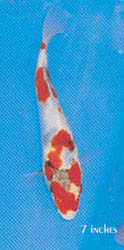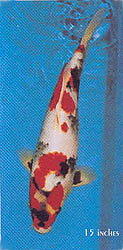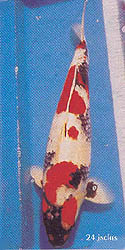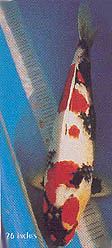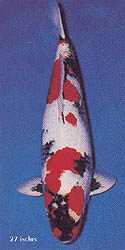"Male Koi Myths" Determining the sex of a young Koi can be a less than exact science. Given the current "bigger-is-better" mind set, there is an ever increasing demand for the considerably more expensive females, which are much more likely to achieve gargantuan proportions. The top awards in the Japanese Koi shows are typically dominated by 30+inch female Kohaku, Sanke, and Showa, and Japan tends to set the trend for the rest of the world. For the average American hobbyist whose pond is between 4,000 to 6,000 gallons, trying to raise a 30+inch female in the United States can be an exercise in futility. Most of us do not have access to summer growing pond where our Koi could achieve maximum growth. A few of us, who have been accused of over stocking our ponds, are perplexed when our Koi don't seem to grow much, but that's another story. Here in the United States, it is rare to see a Grand Champion of over 30 inches, and given our average pond size, it would seem that concentrating on male Koi might not be such a bad idea. Hopefully, this article can help dispel some of the most frequently repeated "Male Koi Myths," which are usually presented as Nishikigoi Dogma.
Mr. Kunizo Narita of Matsudo, Chiba, in October of 1991, purchased this 7 inch Showa from Nagashima, Niigata. Note the nearly complete absence of Sumi (black), and the bright, but scattered hi (red) pattern. Judging by the near perfect white, one would naturallyassume that this youngster was a female (Myth No.1). Mr. Narita took his newly acquired Showa home, where he kept it in a 50 gallon aquarium. By January of 1992, the Showa had grown to 11 inches and was already showing a marked change. The body conformation had undergone a total transformation and was filling out nicely. Sumi was starting to emerge in all the right places and though the beni (red) continued to be bright, the head had developed a yellowish tinge, typical of juvenile males. By April of 1992, ut was clear not only that Mr. Narita's Showa was a male, but that at an astonishing 15 inches, it needed to be moved out of the 50 gallon-aquarium. Again we can see a more defined Sumi pattern, improving body conformation, bright beni, and yellowish head and pectoral fins. In October of 1992, after spending the growing season in a mud pond att Nagashima's farm in Niigata, the Showa emerged measuring over 18 inches. The body concormation has again undergone a drastic improvement (Myth No.5). The head has squared off giving the Koi a mature and imposing apperance. The shoulders have broadened considerably, and the caudal peduncle has thickened, giving an overall impression of great strength. Both the sumi and beni are by this time quite well developed,and the yellowish tinge on the head has begun to dissapear.
Unfortunately, we do not have a photo of the Showa as a three-year-old, but Mr. Narita reports that it measured almost 22 inches. In November of 1994, measuring just over 26 inches, Mr. Narita's Showa displayed a near perfect body conformation. The skin had whitened up beutifully, leaving only a hint of yellow on the head. The beni, now fully established, has deepened and thickened without losing its youthful brightness. The sumi, now fully emerged on the head and pectoral fins, seems to be receding and breaking up on the rest of the body, giving false credence to Myth No.3. On August 1, 1996, in its sixth year and measuring 26 inches, this Showa is finally showing signs of "finishing." The sumi has clearly reestablished itself in classic Showa fashion. Apart from a sparkling of niban hi (secondary red) on the caudal peduncle, the beni is perfect. Although there just the slightest hint of yellow on the head, pectoral fins, and gill plate, one would most likely attribute this condition to the feeding of color inhancing foods that are typically fed at that time of the year. Finally in January of his seventh year, we see a truly well finished male Kindai Showa measuring almost 27 inches. Snow white skin with no trace of yellow-dispellng Myths No. 1 and No.2. Body conformation and size would compete for Grand Champion in any Koi show in the United States - Myths No.1 and No.5. The intensity of the red is possibly better than ever. Note the dissapearance of most of the nidan hi. Mr. Narita's Showa took fist place in its class at the 29th All Japan Combined Koi Show, an honor that many strive for but few achieve. I guess there are two lessons to be learned from Mr. Narita's example:
BACK TO TOP |
||||||||||||||||||
|
|
||||||||||||||||||

